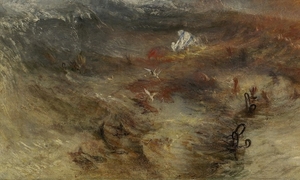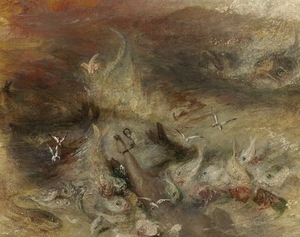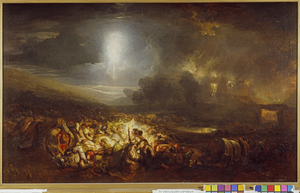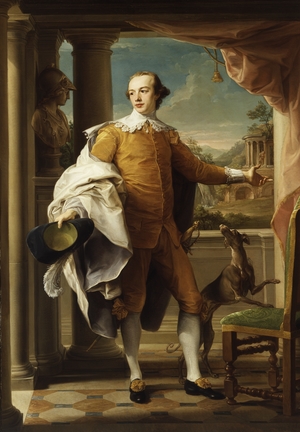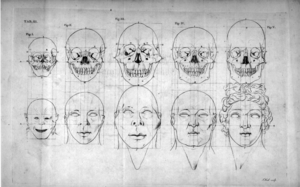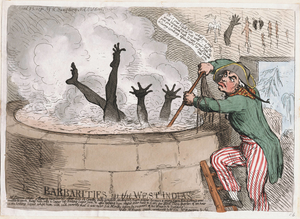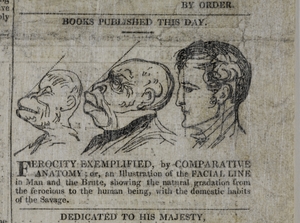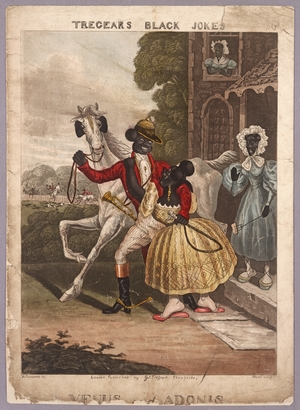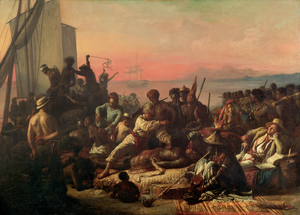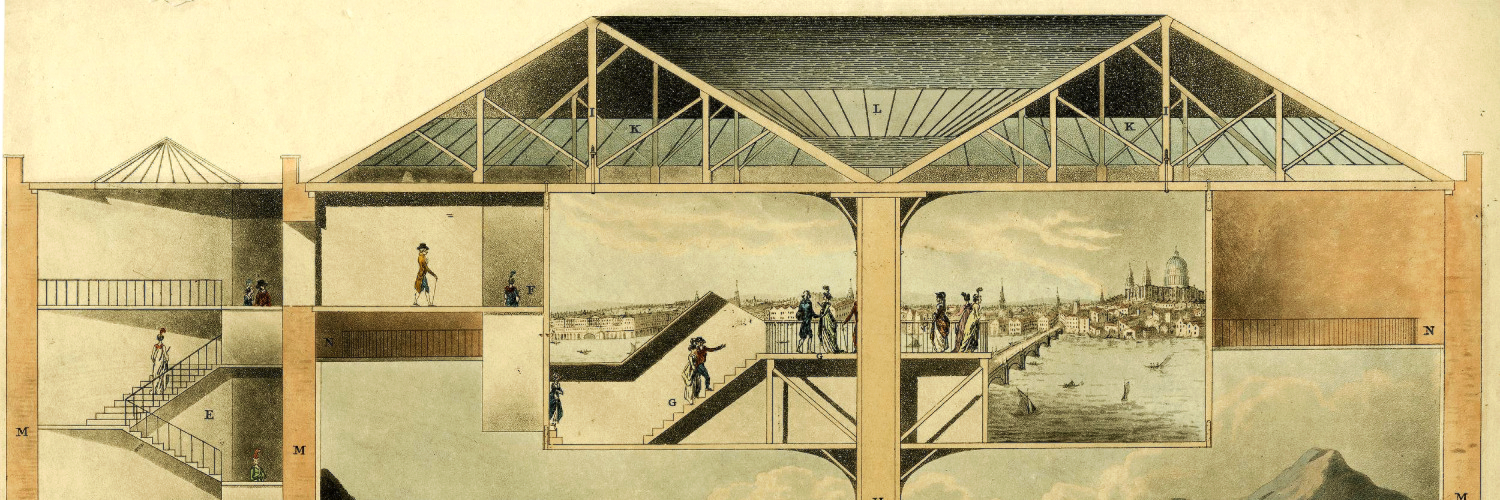‘Is the picture sublime or ridiculous? Indeed I don’t know which.'
’
Writing in Fraser’s Magazine, William Makepeace Thackeray broached the question of the sublime and the ridiculous in his review of J. M. W. Turner’s Slavers Throwing Overboard the Dead and Dying: Typhon Coming On (figure 1), which was on display in the annual exhibition of the Royal Academy in 1840 (731). Thackeray’s ambiguous answer is somewhat disingenuous, judging from the exuberantly sarcastic tenor of his review. In this famous passage, filled with mock horror, for example, he comically rejects the possibility that the painting offers any kind of convincing illusion of the tragic scene suggested by its title: ‘Rocks of gamboges [strong yellow] are marked down on the canvas, flakes of white laid on with a trowel; bladders of vermilion madly spirited here and there. Yonder is the slaver rocking in the midst of a flashing foam of white-lead. The sun glares down upon a horrible sea of emerald and purple, into which chocolate-coloured slaves are plunged, and chains that will not sink; and round these are floundering such a race of fishes as never was seen since the saeculum Pyrrhae, gasping dolphins redder than the reddest herrings; horrid spreading polypi, like huge slimy poached eggs, in which hapless niggers plunge and disappear. Ye gods, what a ‘middle passage’! (731)’ Unlike Thackeray, most scholars writing about the Slavers over the past century have opted for the sublime, despite the fact that they invariably cite Thackeray’s review as well as equally hostile ones by his contemporaries.
In the essay that follows I want to consider the case for the ridiculous, and to suggest that by so doing Turner’s painting can be productively situated with the contemporary Anglo-European discourse on racial difference. In 1990 Paul Gilroy argued that Turner’s Slavers “offers one opportunity to appreciate that English art and aesthetics are not simply in place alongside English thinking about race;” rather, they are “an integral means with which England was able to make sense of itself and its destiny” (51). In the two decades since this statement, many thoughtful accounts of the Slavers have been published, but they have largely ignored issues of race in their eagerness to analyze the painting within the context of the Atlantic slave trade.
Questions of race are deeply intertwined with the institution of slavery in the early modern period. And yet, when considering cultural representations of Atlantic slavery, it is unwise to conflate slavery with race, especially in dealing with visual representation, since aesthetics and visuality have been central to the construction of racial difference from the late eighteenth century forward. Before turning to the “ridiculous,” and racialization, I want to briefly consider how modern scholarship came to assess Turner’s Slavers as a sublimely Romantic masterpiece.
Foundational to this characterization of the Slavers is John Ruskin’s impassioned account from Modern Painters, published three years after its first exhibition (3: 571-3). Relegating to a footnote the subject—the jettisoning of enslaved Africans from a slave ship tossing in a storm-swept sea—Ruskin brings the painting to life. Unlike Thackeray, he makes no references to paint, brushwork, and composition in this passage, only to sublime natural effects such as the “glorious light [. . .] which burns like gold, and bathes like blood,” and “the mist of night [. . .] advancing like the shadow of death upon the guilty ship [. . .] its thin masts written upon the sky in lines of blood, girded with condemnation in that fearful hue which signs the sky with horror” (3: 572). Through Turner’s genius, nature and the slave ship (but not the fish and fragmented human bodies) become the embodiments of horror and beauty, capable of moving the viewer to aesthetic admiration and moral outrage. In producing a work of art capable of eliciting this sort of moral and aesthetic response, the Romantic genius becomes a sort of a superconductor who feels more deeply than ordinary individuals and can brilliantly and beautifully convey those feelings to the less sensitive via his art (Kriz, Idea 87). Ruskin writes in Modern Painters about the special character of the landscape painter who ‘makes him [the spectator] a sharer in his own strong feelings and quick thoughts; hurries him away in his own enthusiasm; guides him to all that is beautiful; snatches him from all that is base; and leaves him more than delighted,—ennobled and instructed, under the sense of having not only beheld a new scene, but of having held communion with a new mind, and having been endowed for a time with the keen perception and the impetuous emotions of a nobler and more penetrating intelligence. (3: 134) ’ This form of shared viewing through the mind of the artist would also seem to involve the spectator with yet another mediator: the Romantic critic. Certainly Ruskin’s fervent prose is every bit as much a performance of the deeply sensitive self as Turner’s painting.
This cultural formation, which insistently values artistic sensibility, also produces “Romantic scholarship”—that is, scholarship driven by the belief that analyzing great art depends on discerning the artistic genius’s feelings and motives so viewers may channel “the keen perception and the impetuous emotions of a nobler and more penetrating intelligence.” Even though much of the recent scholarship on the Slavers has been extremely “contextual,” engaging with the complex histories of Anglo-European colonization and the Atlantic slave system, by and large the scholarship has maintained a Romantic fixation on finding “meaning” in the painting by focusing on Turner. Scholars have considered in detail his intentions, his visual and textual sources, his attitude towards history in general and the slave trade in particular, and more recently his investments—I refer here to Sam Smiles’ recent discovery that in 1805 the artist had invested in a Jamaican venture dependent on slave labor (47).
If we turn our attention away from the artist and toward his contemporary critics, we are immediately confronted with the issue of the ridiculous. Turner’s use of intense, highly-keyed green and purple (lost over time), and the still-brilliant red, orange, white, and yellow in the sky and water attracted bemused criticism (McCoubry 336-7). But even more sport was made of the human fragments (hands and a leg), floating chains, and strange-looking fish located in the foreground ([Thackeray] 731, Eagles 380, "Fine Arts," "Exhibition").
Now, as a glance at nineteenth-century Royal Academy reviews confirms, it was not unusual for a painting—especially a painting by Turner—to provide critics with an occasion to display their talent for withering satire. During the fifty years that Turner had been exhibiting at the Royal Academy, his paintings provoked satiric comments about his paint handling, figures, composition, and color.
But the critics in 1840 did not shrink from making jokes that, while aimed at Turner, also seemed to be at the expense of those fragmented bodies of African slaves who had been cruelly thrown overboard by the slavers and left to drown or be eaten by the fish.
Recall that Thackeray described the “horrible sea of emerald and purple into which chocolate-coloured slaves are plunged, and chains that will not sink ” before turning to the sea life: the “gasping dolphins redder than the reddest herrings; horrid spreading polypi, like huge slimly poached eggs, in which hapless niggers plunge and disappear.” From this almost cannibalistic description of slaves that are chocolate colored—a reference that threatens to turn the slaves into one of the edible New World commodities they produce—one might imagine that their bodies would be clearly visible. But in fact, the slaves are denoted by fragments, primarily hands, which seem at points to be indistinguishable from the dark fish tails silhouetted in the blood-red sun and from the wings of birds flying low over the water (figure 2). Even the largest identifiably human body part in the painting, the dusky-colored leg in the lower right corner (figure 3), is framed between the bodies and tails of two large fish, whose tailfins rhyme with the spread toes and loose chain attached to the foot. This leg drew the attention of the critic for the Times: “the leg of a negro [. . .] is about to afford a nibble to a John Dory, a pair of soles, and a shoal of whitebait”(6). The same leg provided one of Turner’s most consistently hostile critics, the conservative Reverend John Eagles, with the occasion to attempt a pun: in his review for Blackwood’s Magazine he remarked that the “fish claiming their leg-acy is very funny” (380). Marcus Wood has appropriately asked “if indeed this is funny, why is it funny?” He concludes that the bottom-right corner of Turner’s painting centered on the leg is a “tragic-comic lament on the slave trade,” and that the “diving leg implores us to try to understand mass murder by picking up the pieces” (Blind Memory 49, 50). This is a fine piece of impassioned Romantic criticism, undergirded by thorough scholarship and an appropriate application of trauma theory. It constitutes Turner as the Romantic subject and “us” as the privileged viewer. My interest, conversely, is “them”—those contemporary critics who seem to have recognized the comedy, but somehow missed the point.
First, it is worth noting that while Turner often produced figures that were shapeless, ambiguous, or vague, he usually did not emphasize the fragmented body in other scenes of human disaster. Even in the strange and disturbing Field of Waterloo (1818, figure 4), where the dead are rendered as a molten mass, they appear as notionally complete bodies. We cannot know why Turner chose to represent the dead and dying African slaves as fragments in his Slavers, but we can be certain that there was plenty of cultural precedent for doing so.
As Roxann Wheeler has shown, for most of the eighteenth century, human difference was predicated on a range of factors, including religion, clothing, social organization, and language. Skin color and other aspects of physical appearance were registered as differences (often attributed to differences in climate), but they were not foundational to the formation of human categories, which were more often described in terms of “variety,” rather than race (31). By the third quarter of the eighteenth century, however, human difference increasingly became subject to categorization based on physical traits, although socio-cultural differences never lost their power to describe variations in the civility and rudeness of a people. There is no simple explanation for this shift. Contributing factors included the enhanced scientific authority of natural history, now extended to the study of humans (in widely influential writings by Linnaeus and Buffon, for example). The expansion of European exploration and colonization was also a crucial factor, along with the explosion in print culture that brought natural and civil histories of European and non-European peoples to a widening readership. There was also an acceleration of popular interest in the pseudo-science of physiognomy, which claimed that character could be read through an analysis of the shape of the skull and facial features. And, significantly, there was the development of a body of writing on aesthetics, which, like scientific writings, could not avoid taking up the issue of human difference, increasingly posed in racialized terms.
Publications in all these various fields of activity routinely registered human difference through a listing and picturing of physical characteristics such as skin color and the color and texture of the hair, and also the shape of the skull, nose, lips, and skeletal frame. The comparative anatomist Petrus Camper (1722-1789), the widely-read physiognomist Johann Caspar Lavater (1741-1801), and the influential author of books on antique art and aesthetics, Johann Winckelmann (1717-1768), acknowledged the diversity of human groups spread across the globe; however, the “negro”—a term that I use throughout this essay to indicate a socially constructed racial category associated with sub-Saharan African peoples—was frequently positioned as anatomically most distant from the European.
White Europeans also were described via lists of facial features and body parts. Crucially, however, they were normalized in writings on natural history, racial science, and aesthetics through reference to a sculptural ideal based not on the fragment, but rather on a body that was smooth, closed, and complete, and that was most often exemplified by the Apollo Belvedere.
There is, of course a huge irony that that extant version of the statue fueling such admiration in the eighteenth and nineteenth centuries was a fragmented Roman copy after a lost Greek original (the left forearm and fingers of the right hand were restored in the sixteenth century).
It was the restored marble that British travelers encountered when they visited Rome during this time period, and that was reproduced in the many copies that graced British collections. And it was this fantasy of the ideal Apollonian body that grand tourists like Sir Wyndham Knatchbull-Wyndham emulated when he had his portrait painted in the pose of the Apollo by Pompeo Batoni (figure 5). The fact that this ideal body was conjured up from a fragmented copy of a lost original of an imaginary being suggests just how fantastic and precarious the edifice of whiteness was (and still is).
My research indicates that within the intertwined discourses of race and aesthetics there was no viable “negro” counterpart to the Apollo; the black body always failed to measure up to this white ideal, and never could aspire to its perfection (Kriz, Slavery 71ff). The alternative idea of the negro is in fact the bestial body, given over to the base appetites and physical senses, rather than reason, judgment, and (good) taste (Virey 2: 41-2). The most well-known scientific representations of this idea come from a highly influential treatise on skull shape, physiognomy, and human difference by the Dutch anatomist Petrus Camper, first published in 1786. He developed a scale for differentiating between the skulls of certain mammals and various types of humans based on the slant of a straight line drawn from the lip, to the tip of the nose, to the top of the forehead. This “facial line” not only served to distinguish various animal and human types, but also to order them aesthetically: according to Camper, the more vertical the facial line, the more beautiful (100).
One of the diagrams published with the text (figure 6) shows frontal views of the head and skull of an ape, negro, Calmuch (Mongolian), European, and the Apollo, placed in order of increasingly vertical facial lines. By including the head and skull (!!) of the Apollo at the “high” (most beautiful) end of the scale, Camper disrupts the very system of scientific evaluation he sets up, which was based on serial assessments of difference and similitude.
The relationship between the European skull and the Apollo is one based on notion of artistic imitation, not on the principles of comparative anatomy. Whether writers on aesthetics argued for a universal ideal of beauty (such as Johann Winckelmann) or multiple body types that varied by racialized group (such as Joshua Reynolds), only the white European male was considered to have an imitative relationship to the Apollo (Kriz, Slavery 75-6, 86). This relationship was guaranteed by a cultural genealogy that traces a line from the art of the Greeks to the Romans and forward to other European nations.
Camper disparages the idea that cranial similarity between apes and Africans (positioned at the “low” end of the diagram) was a sign of the latter’s bestiality (32). But placing like-shaped objects next to each other within the same field had for centuries been a way of inviting an exploration of their similarities, based on long-standing notions of resemblance and contiguity. The naturalization of the link between the African and the slave—forged over the course of the seventeenth and eighteenth centuries—further promoted the association of the African with the bestial. Long before Africans were enslaved and forcibly transported to the New World, the idea of the slave as beast of burden was a commonplace in writings on slavery. And in the eighteenth century, even the prominent abolitionist Thomas Clarkson agreed with his anti-abolitionist opponents that African slaves had a brutish appearance and diminished mental capacities. In a passage from his Essay on the Slavery and Commerce of the Human Species, published in 1786, he insisted that these are the effects of slavery, not essential qualities (21). Whatever the cause, however, Africans were triply susceptible to charges of animality: because of the alleged similarity of their skulls to apes; their origin in a mysterious continent filled with strange creatures; and their enslavement by Europeans, which was bound to turn humans into beasts.
In art, the racialist (and racist) idea of the negro finds its fullest expression not in antique sculpture, but in caricature, which historically had deployed the rhetoric of the grotesque, the fragmentary, and the excessive, often in conjunction with the animalization of the human. Drawing on visual traditions going back several centuries, many of the British caricatures that were commercially marketed from the eighteenth century onward gleefully used animal imagery to satirize public figures, as well as social and national types.
In these cases, the subject’s character was impugned, but not his or her humanity. But the strong and repeated connection of the negro with the animal in aesthetics, writings on New World slavery, and the emerging scientific discourse on human variety, gave a powerful, legitimating force to caricatures that represented black people as creatures who tested the limits of the human.
One of the most potent caricatures to capitalize on the idea of the fragmented and animalized negro slave was James Gillray’s print from 1791, Barbarities in the West Indias [sic] (figure 7). This caricature makes evident what the “scientific” discourse on the “negro” does not—namely, that the fragmentation of the negro as a racial type thematizes the high level of violence enacted on the black body under Atlantic slavery. According to the inscription on the print, the image is based on a report read before Parliament in 1791 claiming that an English slave driver had punished a slave who insisted he was too sick to work by immersing him in a vat of boiling sugar.
Ronald Paulson has suggested that the sheer excessiveness of the imagery—the wildly gesturing limbs of the victim rhyming with the black human arm and ear that appear alongside the vermin nailed to the back wall—calls into question the political motivation of the print (Paulson 204). And it may well be that this is not an atrocity print designed to convince viewers of the horrors of West Indian slavery, but rather a parody of abolitionist accounts that reveals how ridiculous such claims of suffering really were.
In either case, the excessiveness of the image reinforces the reputation of the West Indian colonies as a space of excess and extremes—of climate, profit taking, and behavior. Through the hyperbolic language of caricature, the artist vividly suggests that everyone who comes in contact with the West Indies is debased—the English driver becomes a monstrous cannibal (a type associated both with the indigenous peoples of West Africa and the West Indies), and the slaves are reduced to body parts that will be eaten or displayed as vermin. And yet, the caricatured English slave driver still represents a deviation from some kind of ideal, virtuous, white body. The black body fragments do not. There is no coherent alternative or ideal that secures the representation of the African slave in caricature as a deviation. Rather these bestial bits are what figure the negro. This trope only gained strength between the publication of Gillray’s print in 1791 and the exhibition of Turner’s Slavers in 1840, with its fragmented bodies that eerily conjure up the boiled, drowning slave in Barbarities.
In 1821, for example, George Cruikshank produced a parody on Camper (figure 8) in which caricature and comparative anatomy join forces to reinforce the negro-ape connection.
This is a quickly executed print that attempts to solicit a cheap laugh from its viewers. But that unguarded laughter acknowledges an acceptance of assumptions about racialized difference that might be deemed unacceptable in other circumstances. Cruikshank’s wood engraving invites its viewers—even those who oppose slavery and the slave trade on humanitarian grounds—to laugh, and thereby confirm as common sense, the bestiality of the African.
The trope of “the negro-as-fragment” was advanced even in caricatures that represented notionally complete bodies.
A case in point is a crude aquatint from 1836, titled Venus and Adonis (figure 9), which depicts a black man stuffed into hunting garb, taking leave of his tearful and overdressed wife.
This is one in a series of prints published by Gabriel Tregear that mocked the alleged attempts of black people to enter refined British society through the performance of its rituals. These black interlopers would likely be identified as immigrants from the West Indies, since Parliament passed the bill abolishing slavery in the British islands two years before this print was published. The caricature’s ironic title affirms the conceptual impossibility of a black Venus or Adonis and the image reinforces this idea by reducing the black figures to a series of ridiculous and disarticulated parts: bulbous noses, pop-eyes, and lumpish hairdos. The garish, unmodulated coloring of black skin set against light fabric, such as the face and frilly white cap of the standing servant on the right, also advances the idea of the black body as a series of ill-formed and disconnected parts.
Laughter and varying degrees of alarm or horror seem to go together in these prints, which attempt to maintain the fiction of racial difference (Cruikshank), or to fantasize about black contamination of white society through ingestion (Gillray), or social invasion (Tregear). We’ve seen that Turner’s Slavers generated a similarly mixed response in 1840, directly put by Thackeray: “Is the painting sublime or ridiculous. I don’t know which.” Andrew Wilton has noted that the fine line separating the sublime from the ridiculous was acknowledged by Turner himself. In one of his sketchbooks, the artist comments that Tom Paine “says that the sublime and the ridiculous are often so nearly related that it is difficult to class them separately. One step above the sublime becomes ridiculous and one step above the ridiculous makes the sublime again” (cited in Wilton 356). In the case of Turner’s Slavers, this fragile line between the sublime and the ridiculous threatens to dissolve, conveying the horrors of slavery via black bodies that are fragmented and degraded to the level of the bestial. The hands are so abstractly rendered that they appear more like glyphs than illusionistic representations, offering the minimal amount of visual information necessary to identify them as hands (Bryson 48-52). Some of them are formally indistinguishable from the wings of birds and the tailfins of the fish hovering around them. It is hard, therefore, to imagine these bits, then, attached to wrists, arms, and bodies. Likewise the leg is so oddly formed and disposed that it is nearly impossible to imagine the body to which it belongs. (McCoubrey 338).
These ill-formed and disconnected extremities have a cartoonish air about them, bringing the ridiculous into direct and dissonant confrontation with the sublimely-marked sea and sky. In this way the painting serves as a visual demonstration of the unstable line between the sublime and ridiculous that Turner referenced in his sketchbook.
If, for a viewer like Ruskin, the horror of the event is brilliantly connoted by the slashing brushwork and clashing colors of sky and sea, the hands and leg would seem to impede viewers from imagining the dead and dying victims lying beneath the waves. These parts seem more like incongruous bits of flotsam, rather than tragic fragments that index a human wholeness. And, as British writers on humor repeatedly insisted, incongruity forms the basis for laughter (Kriz, Slavery 74). James Beattie, for example, wrote in 1764 that “laughter arises from the view of two or more inconsistent, unsuitable, or incongruous parts or circumstances, considered as united in one complex object or assemblage” (602).
Whatever Turner’s motives, then, his painting’s reliance on the device of fragmentation offered his contemporary critics the occasion to treat it like a sublime caricature that did not so much subvert as reinforce the fragmentary image of “the negro” in scientific discourse, civil and natural histories, pro-abolitionist tracts, and caricatures.
Appearing in the same exhibition as Turner’s painting was another on the subject of the slave trade that seemed to offer wholeness in place of fragmentation, and to solicit a sigh of empathy rather than the awful laughter and bafflement generated by the Slavers. François-Auguste Biard’s Bartering for Slaves on the Guinea Coast (figure 10) offers viewers the titillating spectacle of newly captured slaves being whipped (upper left), branded (center left), inspected (center), and led away in coffles (left and right middle ground) as two slave traders, an exotically dressed black and a languorous white, sit and watch (foreground right). This aesthetically conservative display of academic exoticism has been vehemently disparaged by modern scholars. Albert Boime and Marcus Wood have (rightly, I think) attacked Biard for his flagrant sentimentalism and for the sadistic thrills he affords viewers, who are invited to disapprove of and, at the same time, take perverse pleasure in violence, humiliation, and torture so illusionistically presented (Boime 138, Wood, Blind Memory, 44). The work appears to have been a popular favorite at the Exhibition, however; it was taken off the walls of the Academy and presented to Thomas Fowell Buxton, the organizer of the Society for the Extinction of the Slave Trade and for the Civilization of Africa, which was meeting in London in the first week of June 1840 (Boime 37). Decorated with whips and chains, the picture was hung in Exeter Hall for the World Anti-Slavery Convention, which followed directly on the Society’s meeting.
Thackeray raved about Bartering for Slaves, perhaps, as John McCoubrey has suggested, to demonstrate his support for abolition in the face of his savage treatment of the Slavers (345-6): ‘Yonder is a poor woman kneeling before a Frenchman, her shoulder is fizzing under the hot iron with which he brands her, she is looking up shuddering and wild yet quite mild and patient: it breaks your heart to look at her. I never saw anything so exquisitely pathetic as that face. ([Thackeray] 731) ’ John Eagles followed suit: his review of Biard’s picture, was, if anything more enthusiastic than Thackerary’s. Declaring Bartering for Slaves to be “perhaps in reality the most powerful picture in the exhibition,” he concluded that “[w]e have seen representations of horror, of plague, pestilence, and famine—but we never saw a piece of more real deep pathos” (384). For decades abolitionists deployed this kind of sentimental rhetoric in texts and images of suffering slaves in an effort to stir the feelings of white Britons. But, as Saidiya Hartman and Marcus Wood each have shown, these kind of empathic representations involve an act of displacement. In attempting to feel for the slave, the reader/viewer imaginatively (and here, sadistically) takes possession of the slave’s body (Wood, Slavery, Empathy, 16-7; Hartman 18-19). As a result, the spectator ends up feeling “for himself rather than for those whom this exercise in imagination presumably is designed to reach;” in the process the sentimental object is obliterated (Hartman 19).
In Thackeray’s case the spectacle of the suffering slave woman prompts a performance of suffering by both the critic and the viewer (“it breaks your heart to look at her”). This process of displacement and display is flexible and can accommodate a variety of sentimental objects. But, as Hartman notes, the problem of sentimental obliteration is particularly acute in the case of African slaves, since one of the ways the system of plantation slavery rendered black people as “thingly bodies” was to disavow their capacity to feel the physical pain of hard labor and to experience the trauma of separation from homeland and family (18-23).
For all their important aesthetic and ideological differences, then, there is a way that Turner’s Slavers and Biard’s Bartering for Slaves reinforce each other by soliciting similar responses to the suffering black body: they keep the feeling, sentient black body at a distance, threatening it with obliteration or dehumanization. Turner represents slave victims as glyphs that comically mimic fish and birds, and displaces “feeling” from bodies onto the sublime natural elements of sky and sea. Ian Baucom has suggested that this distancing effect in the Slavers is enhanced by the artist’s use of smeared Romantic brushstrokes throughout the composition (275). These blurry strokes serve to abstract what they seem to represent: they show us what we cannot see. In contrast, Biard offers a high degree of figural illusionism in the form of whole black bodies that are reduced to the level of suffering beasts in their “wildness” and passivity, a point that both Thackeray and Eagles emphasize in their reviews.
This double move, promoting sympathy for African slaves and political redress for their plight while maintaining their inferior, savage status, is what allowed slavery to be abolished, but racism directed against black people in Africa and the Atlantic Diaspora to persist and even increase in the nineteenth century.
I want to be clear that I am not saying that Turner’s Slavers is as banal and aesthetically impoverished as Biard’s picture. Rather, I am claiming that at the historical moment in which it was exhibited, the affective viewing relationships the Slavers constitutes between the African body and the white viewer are compatible with that produced by a sentimental mode of representation and also by caricature. One can laugh at, be horrified by, and take empathetic possession of this kind of body—but not imagine an equal power relationship with it. That breakdown of imagination is in part due to the way aesthetics came to occupy the heart of scientific racism. It is all to easy to assume that politically liberal or radical artists who produced aesthetically progressive or modern or difficult works of art in the nineteenth century rendered these works immune to ideological appropriation by conservative interests. But even when—or, especially when—an aesthetically innovative work of art is greeted by confusion, contempt, and laughter among a group of conservative critics and an uncomprehending art public, it can still be actively involved in the production of a regressive “commonsense” notion of racial difference. I am suggesting that one way (among many) to move beyond a Romantic art history is to pay serious attention to the dismissive laughter of seemingly uncomprehending viewers. In the case of the Slavers, that laughter suggests some degree of complicity with, not simply contempt for, an artist who employed tropes and devices that confirm widely-held myths about the partiality and animality of the black body.
Acknowledgements: I am extremely grateful to Jill Casid and Theresa Kelley for their insightful comments on this essay.
Works Cited
List of Figures
![J. M. W. Turner, Slavers Throwing Overboard the Dead and Dying: Typhon Coming On, R. A. 1840, o/c. Photograph © [2011] Museum of Fine Arts, Boston.](/sites/default/files/imported/praxis/visualities/images/Kriz_Figure_1Thumb.jpg)
